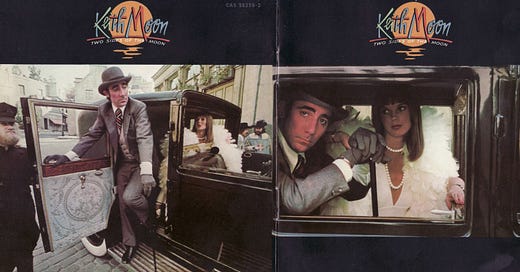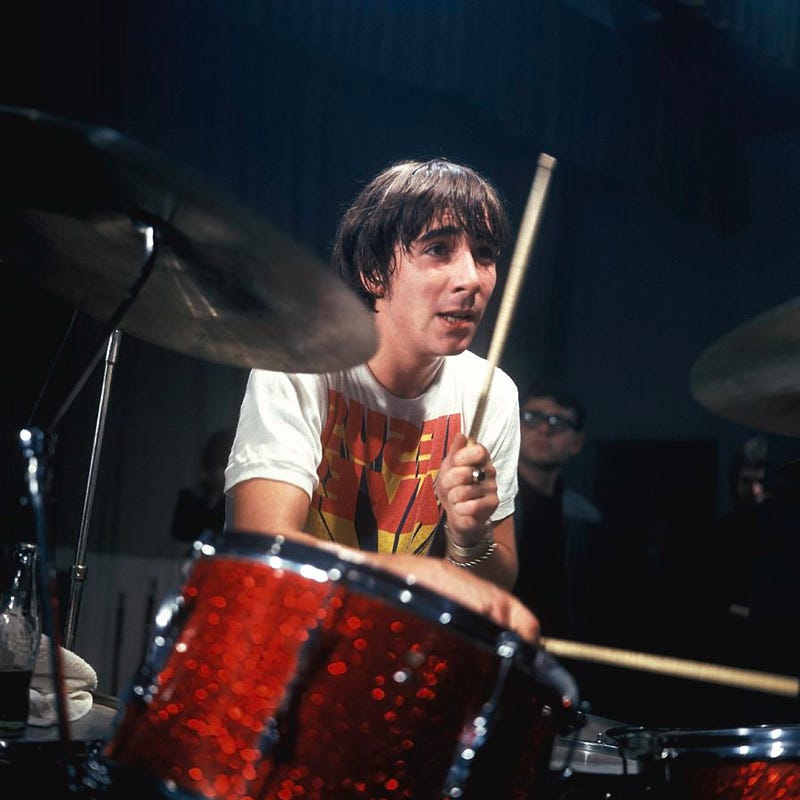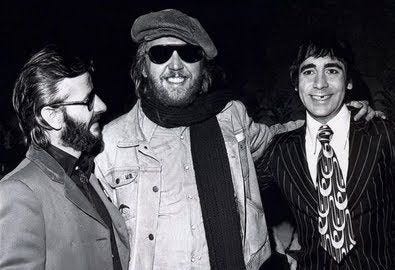Two Sides of the Moon: Keith Moon's Solo Album Disaster
Keith Moon's first and only solo album was going to be a mess no matter what. It could have been an entertaining mess. Instead, its flat out boring.
Keith Moon had always wanted to sing. However, his fellow bandmates in The Who preferred he’d stick to playing the drums and refused to let him sing backing vocals with them. Yet, Moon wouldn’t allow for that. His wild drumming style wasn’t just an expression of his manic personality. It was an expression of his ego and Keith Moon had a huge one. He would try to sneak into the studio to join in on singing but was chased away. The Who’s guitarist and primary songwriter Pete Townshend can be heard yelling “I saw you!” at the end of “Happy Jack” as he caught Moon hiding in the studio. Keith Moon sang a couple of comedically themed songs for The Who, but he wanted more. He wanted to be a serious rock singer and with The Who on hiatus after the Quadrophenia (1973) tour, Moon decided it was the perfect time to shine and record a solo album. What followed was a months long party session which produced a thirty-minute train wreck of an album. The making of Two Sides of the Moon (1975) revealed that Keith Moon wasn’t cut out to be a rock singer and that drugs and alcohol brought out more than two sides of him.
By 1975, Keith Moon had long solidified himself as rock and roll’s craziest and most colorful personality. He destroyed every hotel room he stayed at by blowing up toilets with cherry bombs (he switched to dynamite later because they were more powerful) and throwing furniture out of second-story windows. One time after The Who departed their hotel in a limo to go to the next town, Moon ordered the limo driver to turn around because he had forgotten something. After arriving at the hotel, Moon went up to his room and threw a television out the window where it landed in the pool below. He returned to the limo and told his bandmates “I nearly forgot.” On August 23, 1967, Moon celebrated his 21st birthday by drinking as soon as The Who arrived in Flint, Michigan to open for Herman’s Hermits and was drunk by the time the band went onstage. Upon arriving for his birthday party at the Holiday Inn, Moon started a food fight and during the chaos he lost his front tooth, and drove a Lincoln Continental into the hotel pool. Whether Moon drove a car into the pool has been disputed by historians in the subsequent decades, but why let the truth get in the way of a good story?
Later that same year on December 6, 1967, The Who made an appearance on The Smothers Brothers Hour where they played “My Generation”. As the performance drew to a close, Pete Townshend smashed his guitar against the amplifiers and lead singer Roger Daltrey grabbed one of Keith Moon’s hi-hats and started hitting it. Moon kicked over part of his drum kit and Townshend, standing right next to what was left of Moon’s kit, smashed his guitar on the ground. Unbeknownst to everyone but Keith Moon and The Smothers Brothers Hour’s stagehand he bribed, Moon’s drum kit was loaded with ten times the amount of gunpowder one is allowed to use in a stage production. When Moon triggered the explosives, he set off the equivalent of a miniature bomb that he and Townshend were standing on top of. The explosion caused a piece of Moon’s cymbals to fly into his elbow and when Townshend emerged from the cloud of smoke, his hair was standing straight up, and he could not hear a thing. He then grabbed host Tommy Smothers’ guitar and smashed it. The studio audience thought this spectacle was hilarious while Tommy Smothers was utterly flabbergasted.
On November 20, 1973, Moon was offered a mix of horse tranquilizer and brandy before going onstage for a concert at the Cow Palace in San Fransico, California. He replied, “I can take it; I’m Keith fucking Moon” and downed the entire concoction. It turns out he couldn’t take it. Moon passed out near the end of The Who’s set and was carried offstage by the roadies like a dead deer. During the thirty-minute delay, various attempts were made to revive Moon including dunking his head in ice cold water and giving him a shot of cortisone. When he woke up, Moon was ushered back to his drum kit, but he couldn’t get through one song and passed out again. Instead of cancelling the show, Pete Townshend asked the crowd if there were any drummers out there who wanted to come on stage to finish the show. Scott Halpin, a 19-year-old fan, offered to step behind the drums and after taking a shot of brandy, he became The Who’s temporary drummer for three songs.
While recording some drum parts for Harry Nilsson’s album Pussy Cats (1974), Moon encountered The Beatles former road and assistant produce Mal Evans during a night out on the Sunset Strip. Moon asked if he would be willing to produce his solo album and Evans accepted. Before leaving Los Angeles to film Tommy (1975), Moon recorded a cover of The Beach Boys’ song “Don’t Worry Baby”. After finishing shooting his scenes, Moon returned to Los Angeles to begin working on his debut album. Record companies refused to fund the album on account of Moon’s erratic behavior, the fact he never really sang before, and because he spent money as soon as he got a hold of it. After The Who’s manager Bill Curbishley pulled some strings with the band’s label MCA Records, they agreed to sign Moon to a solo record deal.
Upon listening to Two Sides of the Moon, it’s obvious Keith Moon had no vision for what he wanted his first solo album to be. The only ideas Moon had was to draw inspiration from The Beach Boys and the surf music he admired so much and not to do any drumming. Moon drummed on only three of the tracks and session drummers played on the rest of the album. He also was not a songwriter and Two Sides of the Moon consists of covers of “Don’t Worry Baby” by The Beach Boys, “Move Over Mrs. L” a John Lennon b-side, “In My Life” a Lennon penned Beatles song, and a cover of The Who’s “The Kids Are Alright”.
However, without someone like Roger Daltry or Pete Townshend giving Moon guidance, the record sessions quickly devolved into chaos. The Two Sides of the Moon recording sessions were just a continuation of Keith Moon’s never-ending party. It also provided a way for Moon and his drinking buddies to booze and get stoned on the record company’s dime. The album’s engineer, Gary Ladinsky said Moon and the other musicians would only work for about an hour and then the partying would start. Ringo Starr, Harry Nilsson, Joe Walsh of The Eagles, and Rolling Stones session saxophonist Bobby Keys, some of the most notorious party animals of the 1970s, contributed to some of the songs, but it’s safe to assume they did more carousing than working.
Mal Evans, whose drinking problem certainly wasn’t helped by being around Moon, was fired by MCA once they realized work on the album had barely started. He was replaced by Skip Taylor. Somehow, MCA managed to pick the worst possible replacement. Instead of instilling a sense of discipline in the production, Taylor said “I would go in and decide, is this a night where we should have a little brandy, or should we smoke some stuff, or should we put a couple of lines out?” One change Taylor made was throwing out all of Moon’s vocal recordings and rerecord them. Moon had been drunkenly singing all of the songs in a country twang up to that point and the result was incomprehensible. Instead, Taylor insisted Moon sing with the exaggerated posh British accent he used on “Bell Boy” from The Who’s Quadrophenia album.
Rerecording the vocals proved to be an arduous task due to Moon’s limited vocal range. When Pete Townshend wrote the occasional song for Moon to sing, he made sure it highlighted his mischievous personality and deemphasized anything melodic. Now Moon was singing songs written by other artists which did not suit his singing style. Being reminded of his inadequacies as a singer demoralized him. While recording his vocal parts one night, Moon would smash one of the lights in the studio every time he had to do another take.
When the album was completed, MCA Records had sunk $200,000 into the production with another $200,000 given to Moon as an advance. MCA executives refused to pay for an expensive flash double vinyl cover packaging, but they relented when Moon went into an executive’s office brandishing an ax and threatened to chop up his desk. Two Sides of the Moon was a critical and commercial flop upon its release. Keith Moon’s voice was drowned out by the instruments on most of the songs and at just under a half hour, it’s obvious nobody involved took the record all that seriously. The only critic who liked the album was The Village Voice’s Robert Christgau who found it humorous. The album did not chart. It was presumably a tax write off for MCA.
Keith Moon continued his decade long spiral after Two Sides of the Moon’s release. His drinking and drug abuse escalated and as he neared thirty, this abuse began taking its toll. By the time The Who went into the studio to record Who Are You (1978), Moon’s drumming ability had degraded to the point where he was unable to play most of the tracks. After Pete Townshend threatened to fire Moon for his lackadaisical playing, he began putting more effort into his drumming and vowed to quit drinking. Moon’s weight had also ballooned and during The Who’s photoshoot for the cover of Who Are You, he sat backwards on a chair so the back of it would hide his beer belly. Three weeks after Who Are You’s release, Keith Moon died in his sleep. He was thirty-two years old. Moon was prescribed Heminevrin to combat his urge to drink and he took nearly a third of the pills in the bottle before he went to bed. The pills closed his esophagus and when he vomited, he choked to death. Pete Townshend recalled in the documentary Amazing Journey (2007) “It was a silly mistake. He just always took pills in handfuls. It was just a habit that he had.”
Two Sides of the Moon has become a “so bad it’s good” cult classic in the decades since its release. Yet, I can’t help but feel it was a missed opportunity. An album where everyone involved was drunk or high out of their minds should be entertaining even if it is a disaster. Yet, the record comes off as boring and I can’t help but assume Keith Moon and everyone else involved approached recording the album like homework they had to do before the party started. Moon may have had dreams of being a singer, yet working in the studio clearly bored him and he needed The Who to keep him motivated. If Pete Townshend, who understood Keith Moon’s sense of humor, had written him songs that played to his strengths and mitigated his weaknesses it could have resulted in one of the funniest albums in rock history. Instead, what we have is a snoozefest of a record from an artist who should have given us something gloriously outrageous even if it was destined to be a mess.







